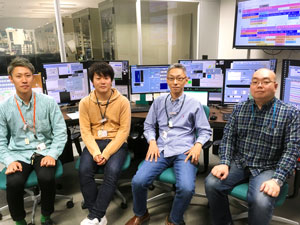Oct. 26, 2018 Research Highlight Physics / Astronomy
First nonlinear spectroscopy of copper using x-rays
Two-photon absorption spectroscopy with high-energy x-rays is a useful new tool for studying transition metal compounds
 Figure 1: By using energetic x-rays generated at SACLA free-electron laser at the SPring-8 site, researchers have realized two-photon absorption spectroscopy of copper for the first time. © 2018 RIKEN SPring-8 Center
Figure 1: By using energetic x-rays generated at SACLA free-electron laser at the SPring-8 site, researchers have realized two-photon absorption spectroscopy of copper for the first time. © 2018 RIKEN SPring-8 Center
By using an intense x-ray source, researchers at RIKEN have demonstrated nonlinear spectroscopy of metallic copper using energetic x-rays for the first time1. This advance will give scientists the opportunity to explore the rich physics of transition metal oxides, including their superconductivity and spin behavior.
X-ray absorption spectroscopy involves the absorption of single x-rays by atoms. It is a powerful tool for probing the electronic structure of solids and surfaces, being routinely used in research in the fields of physics, chemistry and biology.
However, the advent of intense x-ray sources known as free-electron lasers raises the possibility of performing two-photon absorption (TPA) spectroscopy of materials, in which one atom absorbs two x-ray photons in a nonlinear process. This will enable scientists to probe electrons in outer-lying shells, revealing important information that cannot be obtained using single photons.
“X-ray TPA spectroscopy opens a new window into the electronic structure of materials; in particular, it might reveal new insights into the 3d band of cuprates,” explains Kenji Tamasaku of the RIKEN SPring-8 Center. “The 3d state directly relates to useful properties of the 3d transition metal compounds and is thus an important target of research.”
 Kenji Tamasaku (second from right) and his team members at the SACLA free-electron laser facility. © 2018 RIKEN
Kenji Tamasaku (second from right) and his team members at the SACLA free-electron laser facility. © 2018 RIKEN
But a big obstacle to conducting nonlinear spectroscopy using energetic x-rays is the high powers required, which can rapidly destroy samples. Tamasaku and his co-workers overcame this problem by using lower pulse energies and less concentrated focusing and compensating by employing shorter pulses and a more sensitive detector. This strategy enabled them to use the SACLA free-electron laser at SPring-8 to measure the TPA spectrum of copper for the first time. Importantly, the spectrum they obtained differed from that given by single-photon x-ray absorption spectroscopy, demonstrating that using two photons can provide additional insights.
“It was a natural direction of our research to realize x-ray nonlinear spectroscopy with TPA after we had succeeded to observe x-ray TPA for the first time in 2014,” comments Tamasaku. He says that the team chose copper for their first experiments because it is cheap, easy to handle, and plays an important role in high-temperature cuprate superconductors, which are a research topic of great interest.
In addition, by conducting experiments, the researchers determined a condition that specifies when a sample will be destroyed, which will be helpful for future x-ray TPA studies.
The team is now planning to study cuprate superconductors as well as to observe other x-ray nonlinear processes besides TPA.
Related contents
- Taking x-ray lasers to the next level
- Superradiance of an ensemble of nuclei excited by a free electron laser
References
- 1. Tamasaku, K., Shigemasa, E., Inubushi, Y., Inoue, I., Osaka, T., Katayama, T., Yabashi, M., Koide, A., Yokoyama, T., & Ishikawa, T. Nonlinear spectroscopy with X-ray two-photon absorption in metallic copper. Physical Review Letters 121, 083901 (2018). doi: 10.1103/PhysRevLett.121.083901
